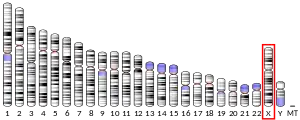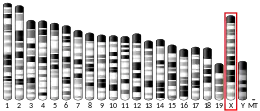Proprotein convertase subtilisin/kexin type 1 inhibitor
Proprotein convertase subtilisin/kexin type 1 inhibitor is a protein by the name of proSAAS that in humans is encoded by the PCSK1N gene. [5]
| PCSK1N | |||||||||||||||||||||||||||||||||||||||||||||||||||
|---|---|---|---|---|---|---|---|---|---|---|---|---|---|---|---|---|---|---|---|---|---|---|---|---|---|---|---|---|---|---|---|---|---|---|---|---|---|---|---|---|---|---|---|---|---|---|---|---|---|---|---|
| Identifiers | |||||||||||||||||||||||||||||||||||||||||||||||||||
| Aliases | PCSK1N, PROSAAS, SAAS, SCG8, SgVIII, BigLEN, PEN, proprotein convertase subtilisin/kexin type 1 inhibitor | ||||||||||||||||||||||||||||||||||||||||||||||||||
| External IDs | OMIM: 300399 MGI: 1353431 HomoloGene: 8315 GeneCards: PCSK1N | ||||||||||||||||||||||||||||||||||||||||||||||||||
| |||||||||||||||||||||||||||||||||||||||||||||||||||
| |||||||||||||||||||||||||||||||||||||||||||||||||||
| |||||||||||||||||||||||||||||||||||||||||||||||||||
| |||||||||||||||||||||||||||||||||||||||||||||||||||
| |||||||||||||||||||||||||||||||||||||||||||||||||||
| Wikidata | |||||||||||||||||||||||||||||||||||||||||||||||||||
| |||||||||||||||||||||||||||||||||||||||||||||||||||
Function
This protein is expressed largely in cells possessing a regulated secretory pathway, such as endocrine/neuroendocrine cells and neurons. The intact proSAAS protein, as well as the carboxyy-terminal peptide containing the inhibitory hexapeptide LLRVKR, functions as an inhibitor of prohormone convertase 1/3, which accomplishes the initial proteolytic cleavage of peptide precursors. ProSAAS is further processed at the N- and C-termini into multiple short peptides, leaving the central segment intact. This central, unprocessed portion of the protein may function as a neural- and endocrine-specific chaperone due to its potent ability to block the aggregation of beta amyloid and alpha synuclein in vitro, and to block oligomer cytotoxicity in cells.[6][7] Recent data show that nigral proSAAS expression blocks the deterioration of the striatonigral pathway in a synuclein rat model of Parkinson's disease.[8] ProSAAS also oligomerizes and undergoes liquid-liquid phase separation.[9] Differential expression of this gene may be associated with obesity.
References
- GRCh38: Ensembl release 89: ENSG00000102109 - Ensembl, May 2017
- GRCm38: Ensembl release 89: ENSMUSG00000039278 - Ensembl, May 2017
- "Human PubMed Reference:". National Center for Biotechnology Information, U.S. National Library of Medicine.
- "Mouse PubMed Reference:". National Center for Biotechnology Information, U.S. National Library of Medicine.
- "Entrez Gene: Proprotein convertase subtilisin/kexin type 1 inhibitor". Retrieved 2017-02-28.
- Jarvela TS, Lam HA, Helwig M, Lorenzen N, Otzen DE, McLean PJ, Maidment NT, Lindberg I (2016). "The neural chaperone proSAAS blocks α-synuclein fibrillation and neurotoxicity". Proc Natl Acad Sci U S A. 113 (32): E4708-15. Bibcode:2016PNAS..113E4708J. doi:10.1073/pnas.1601091113. PMC 4987805. PMID 27457957.
- Hoshino A, Helwig M, Rezaei S, Berridge C, Eriksen JL, Lindberg I (2014). "A novel function for proSAAS as an amyloid anti-aggregant in Alzheimer's disease". J Neurochem. 128 (3): 419–30. doi:10.1111/jnc.12454. PMC 3946950. PMID 24102330.
- Lindberg I, Shu Z, Lam H, Helwig M, Yucer N, Laperle A, Svendsen CN, Di Monte DA, Maidment NT (2022). "The proSAAS Chaperone Provides Neuroprotection and Attenuates Transsynaptic α-Synuclein Spread in Rodent Models of Parkinson's Disease". J Parkinsons Dis. 12 (5): 1463–1478. doi:10.3233/JPD-213053. PMC 9731515. PMID 35527562.
- Peinado JR, Chaplot K, Jarvela TS, Barbieri EM, Shorter J, Lindberg I (2022). "Sequestration of TDP-43216-414 Aggregates by Cytoplasmic Expression of the proSAAS Chaperone". ACS Chem Neurosci. 13 (11): 1651–1665. doi:10.1021/acschemneuro.2c00156. PMC 9731516. PMID 35549000.
Further reading
- Fortenberry Y, Hwang JR, Apletalina EV, Lindberg I (2002). "Functional characterization of ProSAAS: similarities and differences with 7B2". J. Biol. Chem. 277 (7): 5175–86. doi:10.1074/jbc.M104531200. PMID 11719503.
- Wada M, Ren CH, Koyama S, Arawaka S, Kawakatsu S, Kimura H, Nagasawa H, Kawanami T, Kurita K, Daimon M, Hirano A, Kato T (2004). "A human granin-like neuroendocrine peptide precursor (proSAAS) immunoreactivity in tau inclusions of Alzheimer's disease and parkinsonism-dementia complex on Guam". Neurosci. Lett. 356 (1): 49–52. doi:10.1016/j.neulet.2003.11.028. PMID 14746899. S2CID 46034652.
- Kudo H, Liu J, Jansen EJ, Ozawa A, Panula P, Martens GJ, Lindberg I (2009). "Identification of proSAAS homologs in lower vertebrates: conservation of hydrophobic helices and convertase-inhibiting sequences". Endocrinology. 150 (3): 1393–9. doi:10.1210/en.2008-1301. PMC 2654743. PMID 18948394.
This article incorporates text from the United States National Library of Medicine, which is in the public domain.



